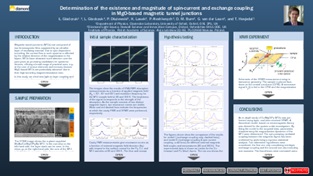
Determination of the existence and magnitude of spin-current and exchange coupling in MgO-based magnetic tunnel junctions
Ł. Gladczuk, L. Gladczuk, P. Dluzewski, K. Lasek, P. Aleshkevych, D.M. Burn, G. van der Laan, and T. Hesjedal
Magnetism and Magnetic Materials Online April 2021
Heterostructures composed of ferromagnetic layers that are mutually interacting through a non-magnetic spacer are at the core of magnetic sensor and memory devices. Such devices can exhibit different types of coupling between magnetic layers, such as: exchange coupling and spin-current mediated coupling. The latter is often rather weak and difficult to observe. We used the technique of x-ray detected ferromagnetic resonance (XFMR) [1] to study the dynamics of a Co/MgO/Permalloy magnetic tunnel junction (MTJ). The experimental results were quantitatively compared to the Landau-Lifshitz-Gilbert-Slonczewski model, and an indepth statistical analysis based on a likelihood ratio test was employed to determine the presence of spincurrent mediated coupling between the two magnetic layers [2]. A strong proof of the existence of spincurrent-like coupling was obtained and the contribution of exchange and spin-current coupling to the overall interaction between magnetic layers was quantified (Fig. 1)

Figure 1: (a) XFMR of the MTJ’s Co layer at 80 K measured for the indicated field values at an angle θH = 10º. The data points in panels (b) and (c) show the amplitude and phase, respectively, extracted from the XFMR signal as a function of magnetic field strength at θH = 20 º (Co - orange, Py - blue). The experimental results are compared with a model with only exchange coupling (dashed lines) and a model with both exchange and spin-current coupling (full lines). Panel (d) shows the combined information about the phase and amplitude on a single plot, where the green and red arrows for Co and Py, respectively, indicate the values of the X and Y parameters used in the likelihood ratio test at a magnetic field of 63.5 mT.
[1] G. van der Laan, J. Electron Spectrosc. Relat. Phenom. 220, 137 (2017).
[2] Ł. Gladczuk et al., Phys. Rev. B 103, 064416 (2021)